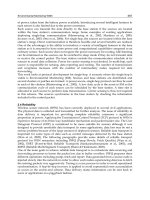Energy Management Systems 2012 Part 15 pptx
Bạn đang xem bản rút gọn của tài liệu. Xem và tải ngay bản đầy đủ của tài liệu tại đây (86.82 KB, 8 trang )
Demand Management and Wireless Sensor Networks in the Smart Grid 15
0 200 400 600 800 1000 1200
0
5
10
15
20
25
30
35
40
45
50
55
Time (5 min intervals)
Market price ($/MWh)
Fig. 10. Electricity price data from an ISO on four days.
next-hour, based on the load forecasts, supplier bids and importer bids. A typical price data
is shown in Fig. 10 (Erol-Kantarci & Mouftah, 2010d).
(Mohsenian-Rad & Leon-Garcia, 2010) proposes an automated load control scheme that aims
to minimize the consumer expenses as well as the waiting times of the delayed demands.
The scheduling scheme is augmented with a price predictor in order to attain the prices of
several hours ahead. This is necessary if the grid operator only announces the prices for the
next one or two hours. In fact, load and price forecasting is widely studied in the literature.
Load forecasts are essential for dispatchers, who are the commercial or governmental bodies
responsible for dispatching electricity to the grid. Load forecasting provides tools for
operation and planning of a dispatcher where decisions such as purchasing or generating
power, bringing peaker plants online, load switching and infrastructure development can
be made (Gross & Galiana, 1987). Electricity market regulators and dispatchers rely on
forecasting tools that provide short, medium and long-term forecasts.
Short-term load forecasts cover hourly or daily forecasts where medium-term forecasts span
a time interval from a week to a year and long-term forecasts cover several years. Forecasting
techniques may differ according to this range. For short-term forecasting, the similar day
approach searches the historical database of days to find a similar day with properties
such as weather, day of the week, etc. (Feinberg & Genethliou, 2006). Regression is
another widely used statistical technique for load forecasting. Regression methods aim to
model the relationship of load and environmental factors, e.g. temperature (Charytoniuk
et al., 1998). Time series methods try to fit a model to data. Previous studies have
employed a wide variety of time series methods such as Autoregressive Moving Average
(ARMA), Autoregressive Integrated Moving Average (ARIMA), Autoregressive Moving
Average with eXogenous variables (ARMAX) and Autoregressive Integrated Moving Average
with eXogenous variables (ARIMAX) methods. Neural networks, expert systems, support
267
Demand Management and Wireless Sensor Networks in the Smart Grid
16 Will-be-set-by-IN-TECH
vector machines and fuzzy logic are among the recent forecasting techniques. The techniques
proposed for load forecasting can be used for price forecasting, as well.
In (Mohsenian-Rad & Leon-Garcia, 2010), the authors use a simple AR process that uses the
price values of previous two days and the same day of the last week. This is due to the weekly
pattern of the consumption data.
3.4 Optimization-based demand management
In this section, we introduce two optimization-based demand management schemes, which
are Decision-support Tool (DsT) and Domestic Optimization and Control techniques.
3.4.1 Decision-support Tool (DsT) for the smart home
In (Pedrasa et al., 2010), the authors propose a Decision-support Tool (DsT) for the smart
homes. The DsT aims to help the household in making intelligent decisions when operating
their appliances. The authors focus on appliances that have high energy consumption,
e.g. PHEV, space heater, water heater and pool pump. The authors define an aggregate,
must-have services such as lighting, cooking, refrigeration,etc., which exists beside the loads
of space heating, water heating and pool pumping services and PHEV charging loads. The
energy consumption properties such as duration, battery capacity, maximum charging rating
are assumed to be determined by the consumer. In the initial phase of DsT, consumers
assign values to those desired energy services. Moreover, DsT assumes the availability of
generation via solar panels and the peak output of the PV is also set at the initial phase. Then,
consumption is optimized by scheduling the available distributed generation, energy storage
and controllable end-use loads which are called as distributed energy resources (DER). The
scheduling algorithm attempts to maximize the net benefits for the consumer which is equal
to the total energy service benefits minus the cost of energy. The cost of energy is based on
a TOU tariff with critical pricing during several hours of a day. The must-run services are
delivered regardless of cost and the other services are restricted to run only during defined
hours. For instance, the pool pump is not allowed to work overnight due to noise issues.
The scheduling of the DER is formulated and solved via the particle swarm optimization
(PSO) heuristic. PSO is a population-based optimization technique that enables to attain
near-optimal schedules within manageable computation times.
In (Pedrasa et al., 2010), the communication among the DER and consumers has not been
considered. However the authors emphasize the significance of coordinated scheduling using
a centralized decision-maker that controls the operation of all the various DERs. The benefits
of having a decision-maker that can access the dynamic prices of electricity as well as weather
forecasts through the Internet, and that can communicate with the sensors have also been
discussed in (Pedrasa et al., 2010).
In Table 2, we give a comparison of the presented demand management techniques that have
similar objectives, i.e. iHEM, RLC, DsT and ECS.
3.4.2 Domestic optimization and control
In (Moldernik et al., 2009; 2010), the authors propose using domestic optimization and control
scheme to achieve the following goals:
• optimize efficiency of power plants
• increase penetration of renewable resources
268
Energy Management Systems
Demand Management and Wireless Sensor Networks in the Smart Grid 17
Method Pricing Comm. Coverage Monthly
cost
reduction
Peak load
reduction
iHEM
(Erol-Kantarci &
Mouftah, 2011b)
Interactive
demand
shifting
TOU Yes local 30% 40%
RLC
(Mohsenian-Rad
&Leon-Garcia,
2010)
Automated
load control
with
LP-based
optimization
Real-time
pricing
No local 10%-25% 22%
DsT
∗
(Pedrasa
et al., 2010)
Particle
swarm
optimization
TOU and
Critical
Peak Pricing
(CPP)
No local 16%-25% N/A
ECS
(Mohsenian-Rad
et al., 2010a)
Game
theoretic
pricing and
scheduling
Proportional
to daily
load and
generation
cost
No neighbor-
hood
37% 38%
∗
Using TOU tariff, no PHEV and no critical peak pricing scenario.
Table 2. Comparison of iHEM, RLC, DsT and ECS.
• optimize grid efficiency
Domestic optimization is based on predicting the demand and the day-ahead prices and
optimize the resources accordingly. The authors use a neural network-based prediction
approach to predict the next-day heat demand. The schedule of the Micro combined heat
and power (micro-CHP) device is determined based on this prediction. CHP, also known as
cogeneration, provides ability to simultaneously produce heat and electricity. Electricity is
generated as a by-product of heating.
The neural network is trained such that a set of given inputs produce the desired outputs. In
(Moldernik et al., 2010), the output of the neural network predictor is the heat demand per
hour. The factors affecting the heat demand is assumed to be the behavior of the residents,
the weather, and the characteristics of the house which are given as inputs to the prediction
model. The data are derived from historical demand and consumer behavior databases.
Following the prediction step, planning of the runs of the microCHP is established. Thus,
the times when the microCHP is switched on is planned. This planning is based on local
decisions. However, a group of houses is considered to act as a virtual power plant where in
the global planning phase, global production is optimized via iterative distributed dynamic
programming. In the next step, the authors schedule the appliances in a single house based
on the global planning decisions. Local appliances are controlled to optimize electricity
import/export of home.
3.5 Summary and discussions
In this book chapter, we grouped the demand management schemes proposed for the smart
grid under four categories as:
269
Demand Management and Wireless Sensor Networks in the Smart Grid
18 Will-be-set-by-IN-TECH
• Communication-based demand management
• Incentive-based demand management
• Real-time demand management
• Optimization-based demand management
Communication-based techniques have been studied in (Asad et al., 2011; Erol-Kantarci
&Mouftah, 2010c; Erol-Kantarci & Mouftah, 2011b; Lui et al., 2010; Yeh et al., 2009). Demand
management schemes that employ WSNs have been presented under communication-based
techniques, as well. Communication-based techniques provide flexible solutions that
can compromise between reducing the energy consumption of the consumers and
accommodating their preferences.
Incentive-based techniques have been studied in (Mohsenian-Rad et al., 2010a;b). These
schemes try to shift the consumer demands to off-peak hours, and in the meanwhile they
provide incentives to the consumers by configuring the prices based on a game theoretic
approach. Incentive-based schemes can shape consumer behavior according to the needs of
the smart grid.
Real-time demand management has been studied in (Mohsenian-Rad & Leon-Garcia, 2010). In
real-time demand management, scheduling makes use of the real-time price of the electricity.
Based on the varying prices an automated load control scheme chooses the appliance
schedules with the objective of minimizing the consumer expenses, as well as the waiting
times of the delayed demands. Those schemes are suitable for the grids where the operators
apply real-time pricing tariffs.
Optimization-based demand management has been studied in (Moldernik et al., 2009;
2010; Pedrasa et al., 2010). Optimization-based demand management assumes that the
consumer demands are known ahead or at least they can be predicted. Local generation
capacity of a house or group of houses is scheduled based the predicted demand profile.
Optimization-based schemes may increase the efficiency of the demand management
programs significantly.
4. Conclusion
Growing demand for energy, diminishing fossil fuels, desire to integrate renewable energy
resources, efforts to reduce Green House Gases (GHG) emissions and resilience issues in the
electrical power grid, have led to a common consensus on the necessity for renovating the
power grid. The key to this renovation is the integration of the advances in the Information
and Communication Technologies (ICTs) to the power grid. The new grid empowered by ICT
is called smart grid.
Smart grid can employ ICT in almost every stage from generation to consumption, i.e.
electricity generation, transport, delivery and consumption. ICT can increase the efficiency
of the generation facilities, transmission and distribution assets and consumption at the
demand-side. In this chapter, we reviewed the demand management schemes for the smart
grid with a focus on the potential uses of Wireless Sensor Networks (WSN) in the building
blocks of the smart grid. We first discussed the use of WSNs at the electricity generation
sites. We, then, continued with power transmission and electricity distribution, and finally
reached to demand-side which is the last mile of the delivery services. WSNs provide
270
Energy Management Systems
Demand Management and Wireless Sensor Networks in the Smart Grid 19
promising solutions for efficient integration of intermittent renewable energy resources,
low-cost monitoring of traditional power plants and high-resolution monitoring of utility
transport assets. Furthermore, WSNs offer vast variety of applications in the field of consumer
demand management.
The ultimate aim of those demand management schemes is to schedule the appliance cycles
so that the use of electricity from the grid during peak hours is reduced which consequently
reduces the need for the power from the peaker plants and reduces the carbon footprint of
the household. In addition, consumer expenses will be reduced as peak hour usage results in
higher expenses. Moreover, the use of locally generated power is aimed to be maximized.
Demand management for the smart grid is still in its infancy. The demand management
techniques introduced in this chapter have been recently proposed, and they need to be
improved as the technology advances. For instance, consumer-in-the-loop or predicted
demands can be mitigated by employing learning techniques from the Artificial Intelligence
(AI) field. This would increase the consumer comfort and pervasiveness of the demand
management applications. Furthermore, those schemes mostly consider conventional
appliances, but in a close future, smart appliances will be commercially available. In this
case, demand management schemes may be extended to allow sub-cycle scheduling. The
availability of such appliances will enrich the opportunities that become available with the
demand management applications of the smart grids.
5. References
Al-Anbagi, I., Mouftah, H. T., Erol-Kantarci, M., (2011). Design of a Delay-Sensitive WSN
for Wind Generation Monitoring in The Smart Grid, IEEE Canadian Conference on
Electrical and Computer Engineering (CCECE), Niagara Falls, ON, Canada.
Asad, O., Erol-Kantarci, M., Mouftah, H. T., (2011). Sensor Network Web Services for
Demand-Side Energy Management Applications in the Smart Grid, IEEE Consumer
Communications and Networking Conference (CCNC’11), Las Vegas, USA.
Brumitt, B., Meyers, B., Krumm, J., Kern, A., Shafer, S., (2000). EasyLiving: technologies for
intelligent environments”, in: Proc of Handheld Ubiquitous Computing, Bristol, U.K.
Charytoniuk, W., Chen, M. S., Van Olinda, P., (1998). Nonparametric Regression Based
Short-Term Load Forecasting, IEEE Transactions on Power Systems, vol. 13, pp.
725-730.
Chong C., Kumar, S. P., (2003). Sensor networks: Evolution, opportunities, and challenges, In
Proceedings of the IEEE, Volume 91 No 8, pp.1247-1256.
Erol-Kantarci, M., Mouftah, H. T., (2010).Using Wireless Sensor Networks for Energy-Aware
Homes in Smart Grids, IEEE symposium on Computers and Communications
(ISCC), Riccione, Italy.
Erol-Kantarci, M., Mouftah, H. T., (2010). The Impact of Smart Grid Residential Energy
Management Schemes on the Carbon Footprint of the Household Electricity
Consumption, IEEE Electrical Power and Energy Conference (EPEC), Halifax, NS,
Canada.
Erol-Kantarci, M., Mouftah, H. T., (2010). TOU-Aware Energy Management and Wireless
Sensor Networks for Reducing Peak Load in Smart Grids, Green Wireless
Communications and Networks Workshop (GreeNet) in IEEE VTC2010-Fall, Ottawa,
ON, Canada.
271
Demand Management and Wireless Sensor Networks in the Smart Grid
20 Will-be-set-by-IN-TECH
Erol-Kantarci, M., Mouftah, H. T., (2010).Prediction-Based Charging of PHEVs from the
Smart Grid with Dynamic Pricing, First Workshop on Smart Grid Networking
Infrastructure in IEEE LCN 2010, Denver, Colorado, U.S.A.
Erol-Kantarci, M., Mouftah, H. T., (2011). Wireless Multimedia Sensor and Actor Networks for
the Next Generation Power Grid. Elsevier Ad Hoc Networks Journal, vol.9 no.4, pp.
542-511.
Erol-Kantarci, M., Mouftah, H. T., (2011). Wireless Sensor Networks for Cost-Efficient
Residential Energy Management in the Smart Grid, accepted for publication in IEEE
Transactions on Smart Grid.
Erol-Kantarci, M., Mouftah, H. T., Management of PHEV Batteries in the Smart Grid:
Towards a Cyber-Physical Power Infrastructure, Workshop on Design, Modeling and
Evaluation of Cyber Physical Systems (in IWCMC11), Istanbul, Turkey.
Feinberg, E. A.,Genethliou, D., (2006). Load Forecasting, Applied Mathematics for
Restructured Electric Power Systems, Springer.
Groba, C., Clarke, S., (2010). Web services on embedded systems - a performance study,
8th IEEE International Conference on Pervasive Computing and Communications
Workshops (PERCOM Workshops), pp.726-731.
Gross, G., Galiana, F. D., (1987). Short-term load forecasting, Proceedings of the IEEE, Vol. 75,
no. 12, pp. 1558 - 1573.
Ilic, M. D.; Le X., Khan, U. A., Moura, J. M. F., (2010). Modeling of Future Cyber
˝
UPhysical
Energy Systems for Distributed Sensing and Control, IEEE Transactions on Systems,
Man and Cybernetics, Part A: Systems and Humans, vol.40, no.4, pp.825-838.
Ipakchi, A., Albuyeh, F., (2009). Grid of the future, IEEE Power and Energy Magazine, vol.7,
no.2, pp.52-62.
Lightner, E. M., Widergren, S.E., (2010). An Orderly Transition to a Transformed Electricity
System, IEEE Transactions on Smart Grid, vol.1, no.1, pp.3-10.
Leon, R. A., Vittal, V., Manimaran, G., (2007). Application of Sensor Network for Secure
Electric Energy Infrastructure, IEEE Transactions on Power Delivery, vol.22, no.2,
pp.1021-1028.
Lesser, V., Atighetchi, M., Benyo, B., Horling, B., Raja, A., Vincent, R., Wagner, T., Xuan, P.,
Zhang, S., (1999). The UMASS intelligent home project, in: Proc. of the 3rd Annual
conference on Autonomous Agents, Seattle, Washington.
Lim Y., Kim H M., Kang S. A., (2010). Design of Wireless Sensor Networks for a Power Quality
Monitoring System. Sensors. 2010; 10(11):9712-9725.
Lu, B., Habetler, T.G., Harley, R.G., Gutierrez, J.A., Durocher, D.B., (2007). Energy evaluation
goes wireless, IEEE Industry Applications Magazine, vol.13, no.2, pp.17-23.
Luan, S W., Teng, J H., Chan, S Y, Hwang, L C , (2009). Development of a smart power
meter for AMI based on ZigBee communication, International Conference on Power
Electronics and Drive Systems, pp.661-665.
Lui, T. J., Stirling, W., Marcy, H. O., (2010). Get Smart, IEEE Power and Energy Magazine,
vol.8, no.3, pp.66-78.
Massoud Amin, S., Wollenberg, B.F., (2005). Toward a smart grid: power delivery for the 21st
century, IEEE Power and Energy Magazine, vol.3, no.5, pp. 34- 41.
272
Energy Management Systems
Demand Management and Wireless Sensor Networks in the Smart Grid 21
Medina, J., Muller, N., Roytelman, I., (2010). Demand Response and Distribution Grid
Operations: Opportunities and Challenges, IEEE Transactions on Smart Grid, vol.1,
no.2, pp.193-198.
Metke, A.R., Ekl, R.L., (2010). Security Technology for Smart Grid Networks, IEEE
Transactions on Smart Grid, vol.1, no.1, pp.99-107.
Mohsenian-Rad, A H., Leon-Garcia, A., (2010). Optimal Residential Load Control With
Price Prediction in Real-Time Electricity Pricing Environments, IEEE Transactions on
Smart Grid, vol.1, no.2, pp.120-133.
Mohsenian-Rad, A H., Wong, V. W. S., Jatskevich, J., Schober, R., (2010). Optimal and
autonomous incentive-based energy consumption scheduling algorithm for smart
grid, Innovative Smart Grid Technologies (ISGT), pp.1-6.
Mohsenian-Rad, A H., Wong, V. W. S., Jatskevich, J., Schober, R., Leon-Garcia, A.,
(2010). Autonomous Demand-Side Management Based on Game-Theoretic Energy
Consumption Scheduling for the Future Smart Grid, IEEE Transactions on Smart
Grid, vol.1, no.3, pp.320-331.
Molderink, A., Bakker, V., Bosman, M. G. C., Hurink, J. L., Smit, G. J. M., (2009).Domestic
energy management methodology for optimizing efficiency in Smart Grids, IEEE
conference on Power Technology, Bucharest, Romania.
Molderink, A., Bakker, V., Bosman, M. G. C., Hurink, J. L.,Smit, G. J. M., (2010). Management
and Control of Domestic Smart Grid Technology, IEEE Transactions on Smart Grid,
vol.1, no.2, pp.109-119.
Newborough, M., Augood, P., (1999). Demand-side management opportunities for the UK
domestic sector, IEE Proceedings Generation, Transmission and Distribution, vol.146,
no.3, pp.283-293.
Newman, H. M., (2010). Broadcasting BACnet, BACnet Today, Supplement to ASHRAE
Journal. Vol. 52, No. 11, pp. B8-12.
Piette, M. A., Ghatikar, G., Kiliccote, S., Koch, E., Hennage, D., Palensky, P., McParland, C.,
(2009). Open Automated Demand Response Communications Specification (Version
1.0). California Energy Commission, PIER Program. CEC-500-2009-063.
Pedrasa, M. A. A., Spooner, T. D., MacGill, I. F., (2010). Coordinated Scheduling of Residential
Distributed Energy Resources to Optimize Smart Home Energy Services, IEEE
Transactions on Smart Grid, vol.1, no.2, pp.134-143.
Rahimi, F., Ipakchi, A., (2010). Demand Response as a Market Resource Under the Smart Grid
Paradigm, IEEE Transactions on Smart Grid, vol.1, no.1, pp.82-88.
Santacana, E., Rackliffe, G., Tang L., Feng, X. (2010). Getting Smart, IEEE Power and Energy
Magazine, vol.8, no.2, pp.41-48.
Shao, S., Zhang, T., Pipattanasomporn, M., Rahman, S., (2010). Impact of TOU rates
on distribution load shapes in a smart grid with PHEV penetration, IEEE PES
Transmission and Distribution Conference and Exposition, pp.1-6.
Shen, L., Wang H., Duan, X., Li, X., (2008). Application of Wireless Sensor Networks in
the Prediction of Wind Power Generation, 4th International Conference on Wireless
Communications, Networking and Mobile Computing, vol., no., pp.1-4.
Sood, V. K., Fischer, D., Eklund, J. M., Brown, T., (2009). Developing a communication
infrastructure for the Smart Grid, IEEE Electrical Power & Energy Conference
(EPEC), pp.1-7.
273
Demand Management and Wireless Sensor Networks in the Smart Grid
22 Will-be-set-by-IN-TECH
Ullo, S., Vaccaro, A., Velotto, G. (2010). The role of pervasive and cooperative Sensor
Networks in Smart Grids communication, 15th IEEE Mediterranean Electrotechnical
Conference (MELECON), pp.443-447.
Yang, Y., Lambert, F., Divan, D., (2007).A Survey on Technologies for Implementing Sensor
Networks for Power Delivery Systems,IEEE Power Engineering Society General
Meeting, vol., no., pp.1-8.
Yeh, L., Wang, Y., Tseng, Y., (2009). iPower: an energy conservation system for intelligent
buildings by wireless sensor networks, International Journal of Sensor Networks
vol.5, no. 1, pp. 9712-9725.
TOU rates. .
274
Energy Management Systems









